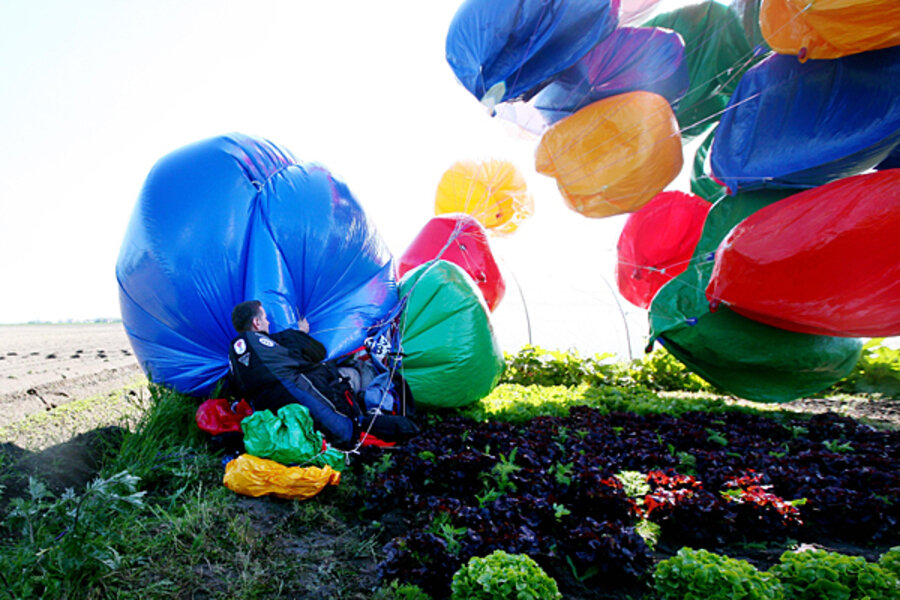American crosses English Channel in chair tied to helium balloons
Loading...
| Boston
The challenge of crossing the English Channel has called to intrepid travelers for centuries.
In 1785, a Frenchman and an American were the first to cross the 21-miles wide swath of water (at its narrowest point) by balloon. In 1875, a Brit was the first to swim the channel – in 21 hours.
Today, to the delight of historians and dreamers alike, American Jonathan Trappe set the world record for the first successful cluster balloon flight (think Disney- Pixar’s film Up!) from England to France.
“I believe there is near universal magic in a cluster balloon flight,” Mr. Trappe wrote in Ballooning Magazine, recently.
“In children’s eyes, a cluster balloon launch embodies all the magic that in the world. In adult’s eyes, seeing a cluster stirs a dream that so many of us once had, but has grown quiet ... Didn’t we dream of holding a bunch of balloons close, and taking to the skies?”
Trappe lifted off from Kent Gliding Club in Challock, near Ashford, England, with more than 54 helium-filled balloons attached to his chair at 5 a.m. Thursday. The night before, a team of helpers spent most of the night filling the balloons before the launch.
To regulate height along the way he simply snipped one balloon away at a time with a pair of scissors, and used water bags as ballast. It took him a little over three hours to float across the Channel to Dunkirk, France. (See video below.)
Trappe's flight was done on the 70th anniversary of the evacuation of Dunkirk beach. Between May 24 and June 4, 1940, some 340,000 Allied troops, including 243,000 British soldiers were rescued from the advancing German army.
Why the Channel?
Trappe also had his eyes on the Channels history - with aviators - as he explained on his website:
"That iconic ribbon of water separating the UK from the continent has called to people for generations, tempting them to cross since long before you or I were born. [Louis] Blériot crossed in 1909 [in an aircraft]. Bryan Allen in 1979 [in a hang glider]. Yves Rossy [in a jet pack] crossed in 2008....
"And here it is, the English Channel, continuing to call to us. I don't know if it is a siren's song, or if crossing that ribbon of water will be like breaking the ribbon at the finish line. With good luck, I will find out today."
When did Cluster Ballooning become popular?
Though the history of attempted cluster balloon travel may go back as long as there has been helium balloons, the sport of cluster ballooning really (ahem) took off in 1982.
That’s when “Lawnchair” Larry Walters flew across San Diego and headlines using weather balloons attached to a lawn chair. He reached heights of 15,000 feet out of control, startled some airline pilots, snared a power line, caused a blackout, and inspired movies. Walters was fined $1,500 by the Federal Aviation Administration.
Another cluster ballooner, Kent Couch, made headlines in 2009. After watching a 2006 episode of the Discovery Channel TV show Myth Busters prove Walters’ feat was possible, “I thought, ‘hey! I can do that,” says Couch in a phone interview. So he did.
Three years later, the gas station owner took off from Bend, Ore., in a lawn chair suspended from more than 150 balloons and flew 242 miles to Idaho, taking what he says is the distance record using cluster balloons.
Mr. Couch says that he received a call from Trappe for advice when Trappe was just getting into cluster ballooning. Of Trappe’s Channel crossing today, he says, “It was a good goal. It’s pretty neat.”
Couch says he was pondering a Channel crossing himself, but has now has his eyes on setting another distance record in July.
Is this safe?
Other cluster ballooning attempts haven’t been as successful.
In 2008, an attempt to break a flight record by Brazilian priest Adelir de Carli near the southern port of Paranagua, Brazil with 1,000 helium filled party balloons tied to a chair, ended in disaster. He went missing in April 2008 and his body was found three months later.
Trappe, however, says he takes safety and preparation seriously. He made sure his chair and balloon contraption was a federally registered aircraft. Though flight plans and a pilot's license is not necessarily required, he had both and cleared the details of his attempt with French authorities. On top of that, he is certified for balloon flight by the US Federal Aviation Administration.
It can be cold dangling from balloons at heights of around 7,000 feet. Temperatures can reach -15 C. Trappe dressed warmly and brought along an aircraft transponder, oxygen system, aircraft radios, emergency locator beacon, in-flight satellite tracking, and a radio tracker according to the Daily Mail.
"Because,” as he told the AP, “really it's only about dreams and enjoying an adventure, and that's only enjoyable when it is safe."
[ Editor's note: The original version misstated the nature of Adelir de Carli's cluster ballooning attempt. ]
RELATED STORIES:





